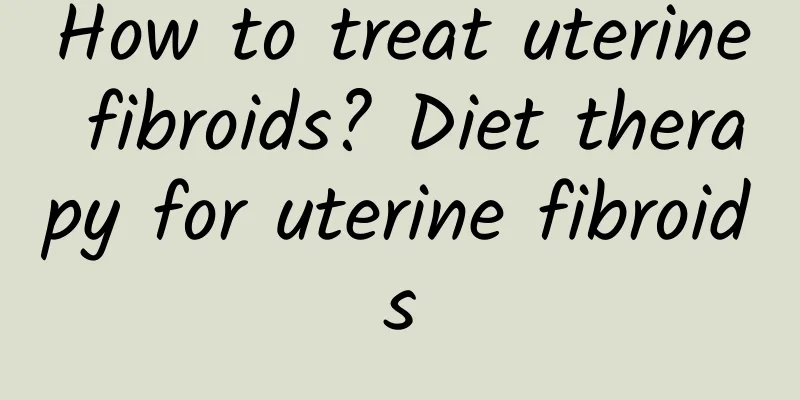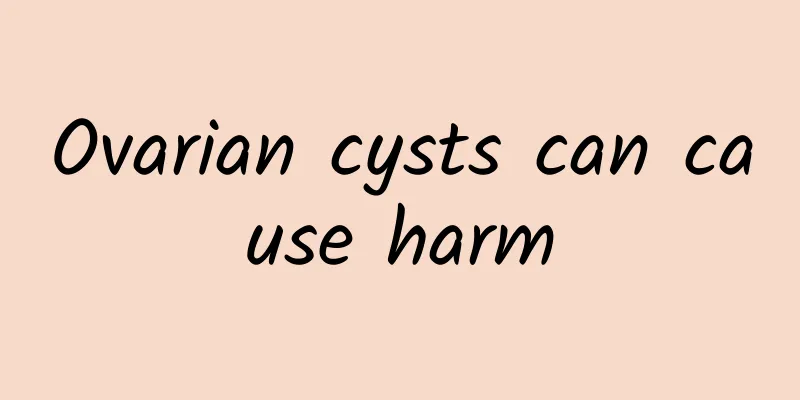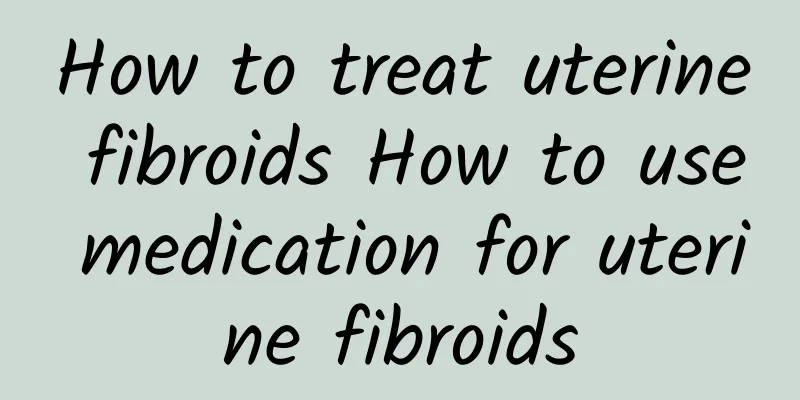How to treat uterine fibroids? Diet therapy for uterine fibroids

|
Uterine fibroids are the most common benign tumors in women. They are composed of smooth muscle and connective tissue and are also called uterine leiomyoma. Common symptoms include uterine bleeding, abdominal mass, vaginal discharge, and bladder and rectal compression symptoms. Let's take a look at the treatment of uterine fibroids? Treatments for uterine fibroids 1. Focused Ultrasound Therapy The temperature inside the tumor is raised locally to above 65°C, causing coagulative necrosis of the tumor and exerting a therapeutic effect. The treatment can shrink the fibroids and relieve symptoms. It is suitable for symptomatic uterine fibroids. There are no surgical scars after treatment, and the advantages are fast recovery after surgery. Side effects include skin burns, intestinal damage, hematuria, etc. 2. Follow-up Observation If the patient has no obvious symptoms and no symptoms of malignancy, regular follow-up observation can be performed. Expectant Treatment Expectant therapy is regular observation and does not require special treatment. It is mainly suitable for asymptomatic uterine fibroids, especially patients with a uterine size of <10-12 weeks of pregnancy. If they are near-menopausal women, it is expected that the fibroids will shrink naturally after menopause. In addition, some asymptomatic small fibroids found during health examinations are common in clinical practice, and patients often go to the doctor anxiously. These patients are diagnosed with uterine fibroids after careful examination and can be treated expectantly without surgical treatment. Review every 3-6 months, paying attention to whether there are symptoms during the period and whether the uterus is enlarged. Each follow-up requires a gynecological examination, supplemented by B-ultrasound examination. If there are symptoms of menorrhagia or compression symptoms or fibroid enlargement, especially at a faster rate, surgical treatment will be used instead. Under regular follow-up monitoring, expectant therapy for asymptomatic uterine fibroids is appropriate. IV. Drug Treatment (1) Commonly used androgen drugs include methyltestosterone (methyltestosterone) and testosterone propionate (testosterone propionate), which can inhibit the growth of fibroids. Pay attention to the dosage to avoid masculinization. (2) Mifepristone is a progesterone antagonist that has been clinically used in the treatment of uterine fibroids in recent years. It can reduce the size of fibroids, but the fibroids grow more after discontinuation of the drug. (3) Gonadotropin-releasing hormone agonist (GnRH-a) Commonly used GnRH-a in clinical practice include leuprorelin (Enanton), goserelin (Zorelaide), triptorelin (Dapiga), etc. GnRH-a should not be used for a long time and is only used for preoperative pretreatment, generally for 3 to 6 months, to avoid causing severe menopausal symptoms caused by low estrogen; small doses of estrogen can also be supplemented to resist this side effect. (4) Tamoxifen can inhibit the growth of fibroids. However, in some patients, uterine fibroids may increase in response and even induce endometriosis and endometrial cancer, so care should be taken. (5) Danazol is used for preoperative medication or treatment of uterine fibroids that are not suitable for surgery. Uterine fibroids may grow after discontinuation of medication. Taking danazol can cause liver damage and androgenic side effects (weight gain, acne, low voice, etc.). 5. Interventional treatment Interventional treatment took place in the last century, mainly injecting embolic agents into the uterine artery to embolize the fibroid blood vessels, leading to ischemic necrosis in the fibroids. However, due to the rich blood supply to the uterus, the actual effect is not ideal. Gynecological clinics sometimes see some patients who were found to have uterine fibroids during cancer prevention surveys. Some women think that uterine fibroids are "cancer, so when they hear about uterine tumors, they are very nervous and under great mental pressure. In fact, uterine fibroids are not terrible. It is the most common benign tumor in the female pelvis, and the rate of malignant change is very low, only 0.3% to 1.39% of married women of childbearing age, and 39% of women are uterine fibroid patients. Uterine fibroids diet Peach eel soup for the treatment of uterine fibroids Ingredients: 12 grams of peach kernels, 6 grams of safflower, 250 grams of shredded eel. Peach kernel: It can break blood and dissipate blood stasis, moisten dryness and lubricate the intestines. It can treat amenorrhea, myoma, blood accumulation due to febrile disease, swelling and pain caused by blood stasis, and constipation due to blood dryness. Safflower: promoting blood circulation and removing blood stasis Eel: Tonifies the body, treats menstrual bleeding Preparation method: stir-fry peach kernels and safflower with water and remove the residue. Stir-fry the eel strips with oil, add fresh soup and medicine to cook together, add ginger, wine, onion, and MSG to make soup, drink the soup and eat the eel strips. Efficacy: Promote blood circulation, eliminate tumors, nourish the kidney and blood. Suitable for those with uterine fibroids and menstruation. Hawthorn, black fungus and brown sugar for treating uterine fibroids Ingredients: 100 grams of hawthorn, 50 grams of black fungus, 30 grams of brown sugar. Hawthorn: Digestive and blood stasis, dissipate blood stasis, treat meat accumulation, symptoms, low back pain, menstrual bleeding, digestive and stomachic, promote qi and dissipate blood stasis. Black fungus: cools blood, stops bleeding Preparation method: Boil about 500 ml of hawthorn water, remove the residue, add soaked black fungus, simmer until soft, and add brown sugar. It can be taken 2-3 times a day, and can be taken for 5 days. It can be taken for 2-3 weeks. Efficacy: Promote blood circulation and remove blood stasis, strengthen the spleen and replenish blood. Suitable for patients with uterine fibroids, menstrual disorders or gynecological inflammation |
<<: How to perform uterine fibroid surgery and what are the common treatments for uterine fibroids?
Recommend
Abnormal leucorrhea is an alarm for women's health
Most of the increased leucorrhea is caused by inc...
Here are some checks you must do before having an abortion:
Before undergoing abortion, you must make certain...
Postmenopausal women should be alert to vulvar leukoplakia
Aunt Zhou has been in menopause for more than a y...
Wearing a mask during training to increase resistance will improve athletic performance? Doctor: Don't try if you have cardiovascular disease, be careful of the risks of exercise
To fight against the new coronavirus disease (COV...
The cause of vulvar leukoplakia can cause local nerve and blood vessel damage
Modern women are under too much pressure in life,...
Does low anti-Mullerian hormone mean premature ovarian failure?
Low AMH does not necessarily mean premature ovari...
Right ovarian cyst symptoms
Right ovarian cyst symptoms: Right ovarian cyst r...
What does inevitable miscarriage mean and what are the causes of inevitable miscarriage?
Inevitable miscarriage is a miscarriage that cann...
How to treat irregular menstruation?
What should we do with irregular menstruation? Th...
Introduction to the examination of congenital absence of vagina
Married women are most worried about gynecologica...
What should women with uterine fibroids do if they want to have children?
Many women in life suffer from uterine fibroids. ...
What are the common clinical manifestations of endometrial tuberculosis?
Endometrial tuberculosis refers to the appearance...
What are the symptoms of lichen sclerosus vulvar leukoplakia?
Patients with hyperplastic and atrophic vulvar le...
Superconducting visual painless abortion is very safe!
Are you still worried about an unexpected pregnan...
What to do if you have uterine fibroids? How to treat uterine fibroids
Nowadays, the incidence of uterine fibroids is gr...









